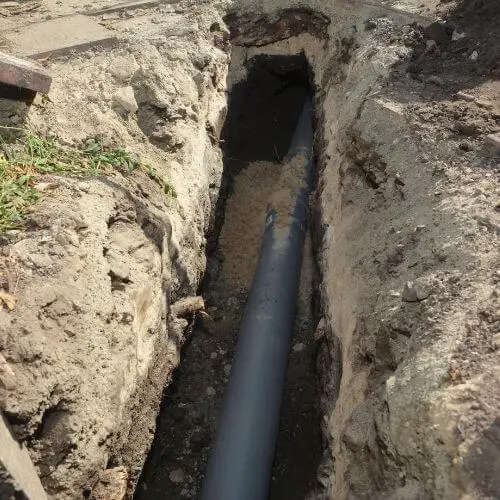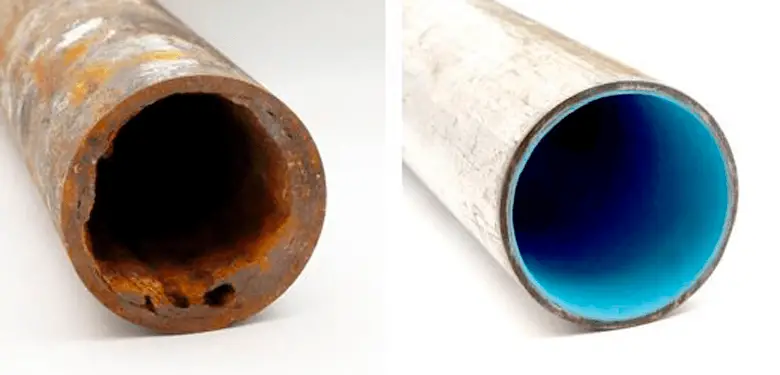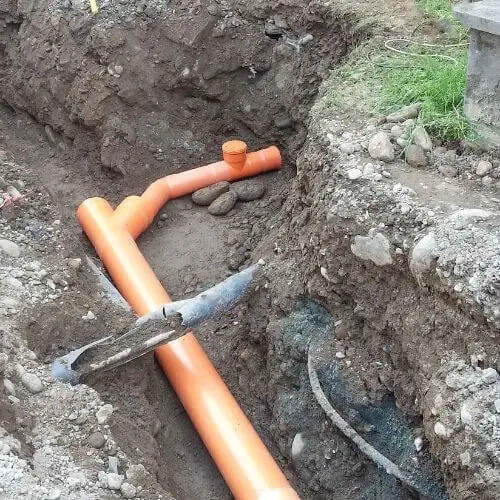Do you constantly deal with low water pressure, gurgling sounds, clogs, and sewer smell outside your house? If so, chances are you’ll soon have to choose either pipe relining vs replacement for your sewer line.
Both of these methods are designed to repair the faulty sewer line. However, they do require different levels of skills, equipment, and amount of time.
You probably heard that the one is better than the other, and you’re here to inspect the facts. While there are certainly Pros & Cons to both of these methods, the perfect one for you will depend on your specific situation.
To help you make the right decision, we have gathered all the information about these two pipe replacement methods.
Signs You Need Sewer Line Replacement

To make sure you’re tackling the right problem, you need to be aware of the symptoms of a faulty sewer line. Some of them include:
- Slow draining
- Low water pressure on well or in the house
- House water or well water is brown
- Sudden greenery at a specific point in a yard
- Infestation of insects or other pests
- Soggy soil in the yard
- Growth of mold and mildew
- Smells like sewage outside the house
More severe damages to sewer pipes are often accompanied by two or more of these symptoms.
It’s very rare that the whole sewer line needs replacement when there is only one symptom present. This is more often the case of a clogged drain, pipeline, or septic tank.
Old houses often need the replacement of the whole sewer line. Even though most pipes last about 50 years or longer, their lifetime can be shortened by three roots or pest damage.
Pipe Relining Vs Replacement

The key difference between pipe relining and replacement is the method of repairing damaged pipes. Pipe relining involves inserting a liner into the existing pipe to repair cracks and leaks, while pipe replacement involves removing the damaged pipe and installing a new one.
Pipe Replacement

Pipe replacement implies a traditional approach – the one that was used before all the other methods and is still used today. Another term used for pipe replacement of this kind is also drainage excavation.
As the term itself says, this type of method does require some digging (a lot of it, actually). It is mostly done by a professional plumber, who has to assess the site before any digging is done.
To minimize the possible damage, the excavation point is made at the best-estimated point. Safety measures are installed across the site, and the assessment of gas and electricity is made to avoid any interference.
The excavation typically requires a team of plumbers and some special equipment. Special excavation machines are used in order to dig up the foundation and lift the concrete blocks.
This is especially the case if you want to replace the sewer line from the house to the street.
When the trench is made, the next step is to either spot-repair the pipe or do a total pipe replacement.
In some cases, it’s possible to solve the problem by replacing only the part of the pipeline. Newer pipes with clogs or pipes penetrated with three roots are among those examples.
However, we recommend the total pipe replacement for most of the cases. The small repairs are a spot treatment that never lasts too long.
Pipe replacement with excavation is an invasive process that requires a team of plumbers for a couple of days and causes landscape damage.
Not only will you be paying the costs for pipe replacement, but you will also have to pay to repair your yard. That’s why, if you do choose this method, you should at least do a total sewer pipe replacement to get your money’s worth.
Pros & Cons of Pipe Replacement
The Advantages of Pipe Replacement Are:
- It’s possible to do it in almost all cases
- Completely replaces your sewer pipeline
- The trench allows for better inspection (in cases of possible three root damage or pest infestation)
The Disadvantages of Pipe Replacement Are:
- It takes more time than some newer methods
- Requires a team of professional plumbers
- Requires the use of special equipment
- The whole process can be loud
- It damages the surrounding areas – including your garden and sometimes the sidewalk
- You need to include the costs for landscape repair [1]
What Is Pipe Relining?
Pipe relining is a newer and not-so-known method for repairing broken pipes. Pipe replacement requires digging, whereas pipe relining requires only a small entry hole.
Pipe relining doesn’t require the use of large equipment, but it does use special equipment which some don’t have.
After a small hole is made in order to get to the sewer pipe, a tube covered with epoxy-resin is inserted into it. When inflated, this pipelining hardens and creates a protective coat by sticking to the pipe interior walls.
The plumbers will also use an electric drain cleaner in order to clean out the pipeline interior walls before inserting the tube. [2]
After the tube is inserted and dried, your pipes will work as efficiently as the new ones.
Some people are worried about the pipe lining taking up the space inside the sewer pipeline. This shouldn’t worry you, as the space, they take up is so insignificant that it doesn’t impact the pipe’s capacity.
Since there is no additional digging involved, less damage is done to your lawn and to the surrounding landscape. Also, this method usually takes way less time.
However, if done incorrectly, this method won’t turn out to be so successful. In order to properly cover the pipeline interior walls, you need to first locate the critical problematic areas.
To do this, plumbers use a special camera that is inserted through the pipe to inspect the problem areas. This also allows the plumbers to see if there are any additional problems, such as roots penetrating the pipe. [3]
Although this coating is strong enough to last for a long time, fixing really damaged pipes with this method is not always advisable.
Pros & Cons of Pipe Relining
The Advantages of Pipe Relining
- It’s less disruptive, and one hole small is enough
- It takes less time to do
- You will be provided with a longer warranty
- Lasts as long as the brand new pipes
- No additional costs for landscape repair
The Disadvantages of Pipe Relining
- Not possible in every situation
- The possible higher initial cost
- Needs special equipment
- Roots can grow into the pipes not properly relined
QUICK NOTE: The possible higher initial cost of pipe relining is not always a downside. When we add up the additional costs of the landscape repair after pipe replacement, the total cost is very similar.
DIY Epoxy Pipe Lining
If you’re more experienced with plumbing jobs, you may decide to save up some money and do the pipe relining yourself.
This process does include the use of certain equipment, so you may DIY only if you have those at hand.
It’s also beneficial to inspect how deep are the sewer lines buried before you decide to do this DIY.
That being said, to do the pipe relining yourself, just follow these steps:
- Insert a sewer camera into the pipeline. By doing this, you will get a more detailed look at what the problem inside the pipe is. A sewer camera also helps you take measurements of the pipe.
- The next step includes cleaning out the pipeline interior walls. This will ensure that the epoxy lining sticks properly when you inflate it. Insert the electric drain cleaner into the pipeline to clean it.
- Your next step will be to use the measurements you got with your sewer camera to cut the pipe liner. You should cut the liner based on the length of the pipe and apply the epoxy coat based on the pipe depth.
- After applying the epoxy resin to the lining sleeve, insert the pipe liner into the pipeline. You have to make sure that this sleeve or liner is fully extended in the pipe before fixing it in place.
- Run the hot water down the pipeline. This will cure the epoxy-coated sleeve in place. Make sure the temperature of the water you’re using is not above 150 degrees Fahrenheit.
- Then, run the cold water to lower the temperature of the materials.
- Check if the epoxy is hardened on the pipe opening.
- Drain the pipeline of excess water. Then, run the sewer camera once again to check if the sleeve is set right in place.
Reasons Why Pipe Relining Fails

If we compare pipe relining vs replacement, relining can be equally as efficient of a method of repair as the second one. However, it needs to be done properly.
There are certain points along the way that are crucial for you if you decide to do pipe relining DIY.
First, you need to have the right materials and equipment in place – especially the right pipe resin. [4]
When buying or even borrowing materials and equipment, you need to be aware of the expiration date. Pipe relining deals with materials that are meant to last for 50 years or longer, so don’t skip this part.
Secondly, you need to properly assess the pipe after the insertion of the sewer camera. This special camera should make the process easier, and if you don’t know how to do it, it’s best to ask for help.
Next, don’t skip the preparation phase of the old pipe. The new sleeve cannot adhere well to the interior pipe walls if the walls are not cleaned prior to that.
The other thing is – that your installation skills really do need to be on point. It’s safe to say that if you’ve never done this before, it’s beneficial to have a helping hand.
Relining Cast Iron Pipe
If you have cast iron pipes, a trenchless pipe repair might be very beneficial for you. Not only does it provide quicker results, but it also comes with less damage to the surrounding landscape.
Cast iron pipes are known for their durability and resistance to fire and pest infestations. When used as water pipes, they also make less noise. [5]
However, even cast-iron pipes need to be replaced after 20-50 years. This is especially the case for the cast iron pipes in the sewer lines of older houses.
Luckily, cast iron pipes can also be recovered by the use of epoxy resin liners or sleeves. It’s a less invasive method that can extend the lifespan of your cast iron pipes that started to deteriorate.
The epoxy sleeve can repair the cast iron pipes in situations where their pipes are burst or worn. Providing the cast iron pipes with an added lining can improve the efficiency of older pipes too.
Even if you decide not to do it yourself, there are many companies providing this service. Nowadays, professional pipe relining can be done within just a few hours!
Even with higher initial costs, this allows you to save up money in the long run. The new pipe lining usually lasts for another 50 years on cast iron pipes.
Since there will not be any surrounding damage, you won’t need to pay additionally for that.
Pipe Relining Vs Replacement Cost
Most who research pipe relining vs replacement usually search for “pipe relining near me” in order to get the costs.
This is totally understandable since the cost of these repairs can vary depending on your location. That’s why it’s recommended for you to research the local prices in your specific area.
Pipe relining costs between $100-$250 per linear foot. On the other hand, pipe replacement costs between $50-$250 per linear foot.
There also may be some additional costs, no matter the method you choose. This applies to the cost of removing tree roots in the sewer line.
Read Also: Is Hydro Jet Cleaning Worth It
The Verdict
If you’re choosing between pipe relining vs replacement, our recommendation is to go with pipe relining.
There are many reasons why this method will be a better decision for you. Pipe relining is newer, quicker, less damaging, and more cost-effective.
However, because it’s not always possible to do relining, you may want to choose total pipe replacement. The same goes for the severely damaged sewer lines.

Michael Davis is a heating & plumbing expert who currently works as independent contractor in SC. He also writes for Plumbertip.
For almost 10 years he worked on various plumbing tasks across South Carolina.


